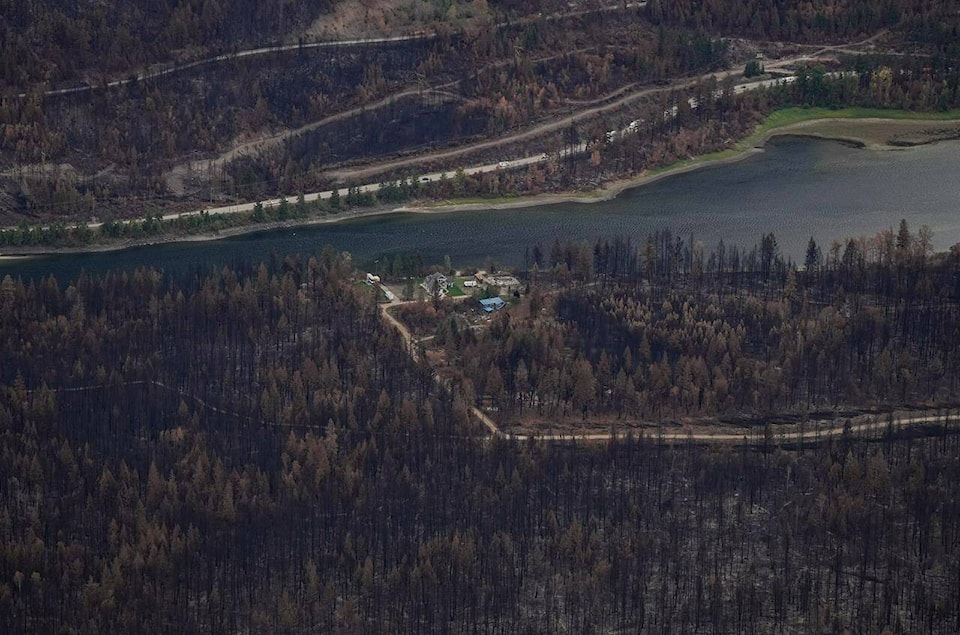More than 200 people took the opportunity to voice their concerns and ask questions regarding last summer’s Bush Creek East Wildfire that destroyed more than 43,000 hectares of land.
The fire that tore through the North and South Shuswap and Skwlāx te Secwepemcúl̓ecw destroyed more than 250 structures.
Acknowledging that the wildfire was a traumatic event unlike any the Columbia Shuswap Regional District had ever experienced, CSRD hired a private consultant to facilitate six community conversations – four in person and two on Zoom.
As well as offering an opportunity for people to provide feedback, the purpose of these meetings was to help the regional district team learn how people received information during the fire, share information about the CSRD’s role in an emergency, gather information to improve the regional district’s preparedness for future events and offer resources such as FireSmart.
Members of the CSRD team included Chief Administrative Officer John MacClean, General Manager, Community and Protective Services Derek Sutherland, Deputy Fire Chief Sean Coubrough, Emergency Program Coordinator Tom Hansen, Emergency Support Services Coordinator Cathy Semchuk, Communications Coordinator Tracy Hughes and FireSmart rep Sophie Randell.
MacLean explained the CSRD’s roles and responsibilities and areas that are outside of the regional district’s scope. Other team members explained their own roles.
Sutherland, who fielded some of the more difficult questions about evacuation and residents who wanted to stay behind to fight the fires, the Alertable app and communications, described attendees’ attitude at the weeklong series of meetings as being overall Incredibly civil.
“People had those hard conversations in a respectful way, and there was a tone I appreciated throughout the meetings, he says. “We’re Canadians in the end and even if we don’t agree with one another, we still act cordial to one another.”
Sutherland says the CSRD team heard several complaints about the evacuation route through Seymour Arm and says the problem is something the regional district can deal with immediately. As well, he noted issues with Alertable have also been addressed.
“People want to vent to somebody and nobody else is getting in front of them,” he says of the regional district’s decision to hold the community conversations. “There is no direct line to BC Wildfire so we felt it was
Incumbent on us to capture what we heard, provide it to our partners and integrate the changes we make into our systems.”
From her perspective, Alyson Gourley-Cramer, Principal and CEO Of Monogram Communications, says she and her team understood through social media and meetings with CSRD that people had gone through tremendous trauma.
“But that never gives you the pulse of the impact on people, it takes meeting with them,” she says, noting that Monogram chose not to use a town hall approach where the host sits on one side of a table and attendees go to a microphone to vent.
“The challenge with that is it doesn’t allow for multiple voices to be heard and our goal was to hear from as many people as possible,” she says. “Each of us in the room spoke to countless numbers of people, listened to them genuinely and took their feedback and their stories, which resulted in building relationships and rebuilding trust.”
At the in-person meetings, following the initial CSRD presentation, attendees could view display materials at tables around the room and speak to experts at each one. A key element in the meetings, Gourley-Cramer says it provided a connection between people who were able to tell their stories.
“My impression was twofold; on the community side, I was just so impressed that people were able to step away from their anger and really convey an understanding of the role of the CSRD, and then literally come to the table to rebuild the trust,” she says. “ And they also shared fantastic suggestions from their points of view; people moved past things so beautifully, which you don’t always see in these situations.”
Gourley-Cramer says in her opinion, CSRD was committed to being available and listening without being defensive.
“We were honoured to be part of it, and seeing the community come together was really inspiring,” she says, noting her report will be presented to the CSRD board in April. “We’re building a report, but the most encouraging thing in this process is it’s not going to be a surprise; they (CSRD) have gone through all this learning with people in the room.”
Monogram Communications began in 2019 with a very small team but has grown to have team members throughout B.C. and others in Alberta. The company works with clients to share their stories, engage audiences, and deliver results for multiple sectors and organizations, regardless of size.
